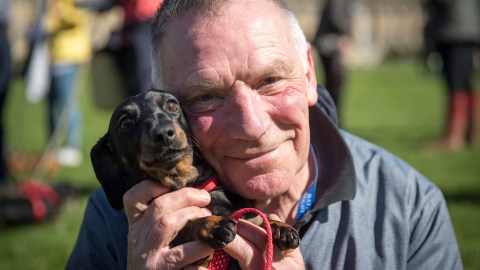Are humans domesticated animals?

Animal husbandry is perhaps 30,000 years old, starting with the humble dog. Several species came afterward and domestication was born. What most people may not know is that there’s one species that became domesticated even before the dog, and that’s us. But to understand why, we need to know the nuances of the various definitions of domestication and where they come from. Domestication is generally defined as the purposeful breeding of a plant or animal for human benefit. But science looks at it a tad differently.
The science of domestication
Domestication syndrome is the physical traits that occur to a wild plant or animal as it becomes domesticated. For mammals this includes things like floppy ears, shorter muzzles, curly tails, white hair—particularly prominent in dogs, cats, and rabbits, and lighter colored coats. Other physical characteristics include smaller brains, shorter limbs, and smaller teeth. There are changes in personality too which include sociability, tameness, and even juvenile behavior.
Darwin first noticed this not among the unique species of the Galapagos but in the common pigeon along the Thames and how much it differed from the fancier varieties Londoners kept as pets. Those beautiful, compliant ceremonial doves? They’re actually just white pigeons. He likened the differences to the kept bird’s better diet, comfier living conditions, and its ability to interbreed with other domesticated birds, leading to hybridization. Humans and animals entirely similar in the respect that each is shaped by the environmental circumstances thrust upon them.

Is it diet, breeding, and a cushier lifestyle that causes domestication, or something more? Credit: Getty Images.
The Soviet experiment
In 1959, Soviet geneticist Dmitry Belyaev began breeding wild foxes to study how they became domesticated over time. He took the most social ones and mated them. Over 10 generations, Belyaev witnessed a dramatic change in them. Personality wise, the foxes became more sociable and playful over time. Physically, they began to have floppier ears, smaller skulls, and patches of white fur in their coats. The males also started to more closely resemble females. What he had found was that domesticated mammals who spent a lot of time with humans and were bred for sociability over generations exhibited similar traits.
This discovery of domestication syndrome didn’t just focus the lens on animals but back onto us as well. Our jaws are small and rounded, our brains smaller than that of the Neanderthal—one of our closest (though extinct) ancestors. At the time, being a discomforting thought with little hard evidence to support it, the idea that humans are also in a way domesticated was lost, mostly, because it was hard to test.
Since that time, a combination of advancements in genetics, our understanding of human evolution, and a number of important paleontological discoveries have led to greater insight into our own species’ development. This, in turn, had led to a recognition of this strange phenomenon and once again thrust it into the spotlight. In 2014, an international team of scientists made a discovery that changed the way we look at domestication and human evolution dramatically.
The neural crest cell hypothesis
Richard Wrangham of Harvard, Adam Wilkins, now at Humboldt University in Germany, and Tecumseh Fitch at the University of Vienna, Austria, came up with what’s known as the neural crest cell hypothesis. Together, they found what connects all of the traits associated with domestication including changes to the teeth, ears, skin, and temperament. They all originate in the neural crest.

The neural crest is a congregation of cells that forms in a developing embryo. This tiny mass eventually breaks up and becomes different tissues in the body, including the adrenal glands—responsible for the stress response (and in a way, temperament), cartilage in the ears, melanocyte cells which create the skin’s pigment, and dentin which forms the teeth. They also earmarked dozens of genes associated with domestication, each one linking back to the neural crest.
Researchers could then compare domestication genes with those found in the genomes of an animal’s wild counterpart. Surprisingly, the genetic changes that caused domestication were the same across all mammalian species, whether it be from wolves to dogs, European bison to cattle, or Neanderthals to humans. The genetic changes that drove these transitions were identical.
So if humans domesticated other species, who or what domesticated us?
If we look at human domestication as changes that allowed us to work and live together to survive, you can say evolution tamed us. Around 100,000 years ago, our species began living closer together. It would’ve been better to cooperate with new neighbors than fight them. Around that same time, the pronounced brow ridges and long faces humans once had were being replaced by smoother, softer, more feminine features.

Scientists believe that the same forces which helped shape domestic animals also affected us. Credit: Getty Images.
One theory is that when our bodies and brains grew bigger, we became less aggressive. Larger animals with bigger brains tend to act more peaceably. This is domestication through natural selection. Those humans who were less aggressive and more cooperative were more likely to pass on their genes, and so these traits became a signature part of our species. Then, interacting with other species over time molded them in the same way. Keep in mind that this is all very new to science and more research must be done to better understand the phenomenon.
To learn more about domestication, click here.





